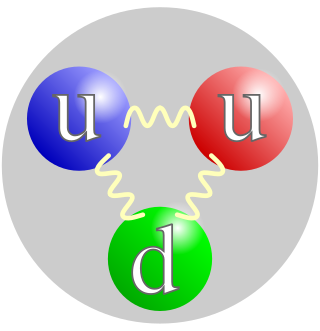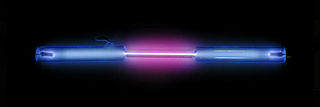
In particle physics, a hadron is a composite subatomic particle made of two or more quarks held together by the strong interaction. They are analogous to molecules that are held together by the electric force. Most of the mass of ordinary matter comes from two hadrons: the proton and the neutron, while most of the mass of the protons and neutrons is in turn due to the binding energy of their constituent quarks, due to the strong force.

In physics and chemistry, a nucleon is either a proton or a neutron, considered in its role as a component of an atomic nucleus. The number of nucleons in a nucleus defines the atom's mass number.

The omega baryons are a family of subatomic hadron particles that are represented by the symbol
Ω
and are either neutral or have a +2, +1 or −1 elementary charge. They are baryons containing no up or down quarks. Omega baryons containing top quarks are not expected to be observed. This is because the Standard Model predicts the mean lifetime of top quarks to be roughly 5×10−25 s, which is about a twentieth of the timescale for strong interactions, and therefore that they do not form hadrons.

In physics, a subatomic particle is a particle smaller than an atom. According to the Standard Model of particle physics, a subatomic particle can be either a composite particle, which is composed of other particles, or an elementary particle, which is not composed of other particles. Particle physics and nuclear physics study these particles and how they interact. Most force carrying particles like photons or gluons are called bosons and, although they have discrete quanta of energy, do not have rest mass or discrete diameters and are unlike the former particles that have rest mass and cannot overlap or combine which are called fermions.

A pentaquark is a human-made subatomic particle, consisting of four quarks and one antiquark bound together; they are not known to occur naturally, or exist outside of experiments specifically carried out to create them.
In particle physics, the hyperchargeY of a particle is a quantum number conserved under the strong interaction. The concept of hypercharge provides a single charge operator that accounts for properties of isospin, electric charge, and flavour. The hypercharge is useful to classify hadrons; the similarly named weak hypercharge has an analogous role in the electroweak interaction.
In nuclear physics and particle physics, isospin (I) is a quantum number related to the up- and down quark content of the particle. More specifically, isospin symmetry is a subset of the flavour symmetry seen more broadly in the interactions of baryons and mesons.
A hypernucleus is similar to a conventional atomic nucleus, but contains at least one hyperon in addition to the normal protons and neutrons. Hyperons are a category of baryon particles that carry non-zero strangeness quantum number, which is conserved by the strong and electromagnetic interactions.

In particle physics, a hyperon is any baryon containing one or more strange quarks, but no charm, bottom, or top quark. This form of matter may exist in a stable form within the core of some neutron stars. Hyperons are sometimes generically represented by the symbol Y.

In physics, the eightfold way is an organizational scheme for a class of subatomic particles known as hadrons that led to the development of the quark model. Working alone, both the American physicist Murray Gell-Mann and the Israeli physicist Yuval Ne'eman proposed the idea in 1961. The name comes from Gell-Mann's (1961) paper and is an allusion to the Noble Eightfold Path of Buddhism.
In particle physics, flavour or flavor refers to the species of an elementary particle. The Standard Model counts six flavours of quarks and six flavours of leptons. They are conventionally parameterized with flavour quantum numbers that are assigned to all subatomic particles. They can also be described by some of the family symmetries proposed for the quark-lepton generations.
In astroparticle physics, an Urca process is a reaction which emits a neutrino and which is assumed to take part in cooling processes in neutron stars and white dwarfs. The process was first discussed by George Gamow and Mário Schenberg while they were visiting a casino named Cassino da Urca in Urca, Rio de Janeiro. As Gamow recounts in his autobiography, the name was chosen in part to commemorate the gambling establishment where the two physicists had first met, and "partially because the Urca Process results in a rapid disappearance of thermal energy from the interior of a star, similar to the rapid disappearance of money from the pockets of the gamblers on the Casino de Urca." In Gamow's South Russian dialect, urca can also mean a robber or gangster.
The Xi baryons or cascade particles are a family of subatomic hadron particles which have the symbol Ξ and may have an electric charge of +2 e, +1 e, 0, or −1 e, where e is the elementary charge.

The lambda baryons (Λ) are a family of subatomic hadron particles containing one up quark, one down quark, and a third quark from a higher flavour generation, in a combination where the quantum wave function changes sign upon the flavour of any two quarks being swapped. They are thus baryons, with total isospin of 0, and have either neutral electric charge or the elementary charge +1.
In particle physics hexaquarks, alternatively known as sexaquarks, are a large family of hypothetical particles, each particle consisting of six quarks or antiquarks of any flavours. Six constituent quarks in any of several combinations could yield a colour charge of zero; for example a hexaquark might contain either six quarks, resembling two baryons bound together, or three quarks and three antiquarks. Once formed, dibaryons are predicted to be fairly stable by the standards of particle physics.

In classical physics and general chemistry, matter is any substance that has mass and takes up space by having volume. All everyday objects that can be touched are ultimately composed of atoms, which are made up of interacting subatomic particles, and in everyday as well as scientific usage, matter generally includes atoms and anything made up of them, and any particles that act as if they have both rest mass and volume. However it does not include massless particles such as photons, or other energy phenomena or waves such as light or heat. Matter exists in various states. These include classical everyday phases such as solid, liquid, and gas – for example water exists as ice, liquid water, and gaseous steam – but other states are possible, including plasma, Bose–Einstein condensates, fermionic condensates, and quark–gluon plasma.

The atomic nucleus is the small, dense region consisting of protons and neutrons at the center of an atom, discovered in 1911 by Ernest Rutherford based on the 1909 Geiger–Marsden gold foil experiment. After the discovery of the neutron in 1932, models for a nucleus composed of protons and neutrons were quickly developed by Dmitri Ivanenko and Werner Heisenberg. An atom is composed of a positively charged nucleus, with a cloud of negatively charged electrons surrounding it, bound together by electrostatic force. Almost all of the mass of an atom is located in the nucleus, with a very small contribution from the electron cloud. Protons and neutrons are bound together to form a nucleus by the nuclear force.
PSR J1614–2230 is a pulsar in a binary system with a white dwarf in the constellation Scorpius. It was discovered in 2006 with the Parkes telescope in a survey of unidentified gamma ray sources in the Energetic Gamma Ray Experiment Telescope catalog. PSR J1614–2230 is a millisecond pulsar, a type of neutron star, that spins on its axis roughly 317 times per second, corresponding to a period of 3.15 milliseconds. Like all pulsars, it emits radiation in a beam, similar to a lighthouse. Emission from PSR J1614–2230 is observed as pulses at the spin period of PSR J1614–2230. The pulsed nature of its emission allows for the arrival of individual pulses to be timed. By measuring the arrival time of pulses, astronomers observed the delay of pulse arrivals from PSR J1614–2230 when it was passing behind its companion from the vantage point of Earth. By measuring this delay, known as the Shapiro delay, astronomers determined the mass of PSR J1614–2230 and its companion. The team performing the observations found that the mass of PSR J1614–2230 is 1.97 ± 0.04 M☉. This mass made PSR J1614–2230 the most massive known neutron star at the time of discovery, and rules out many neutron star equations of state that include exotic matter such as hyperons and kaon condensates.

PSR J0348+0432 is a pulsar–white dwarf binary system in the constellation Taurus. It was discovered in 2007 with the National Radio Astronomy Observatory's Robert C. Byrd Green Bank Telescope in a drift-scan survey.









